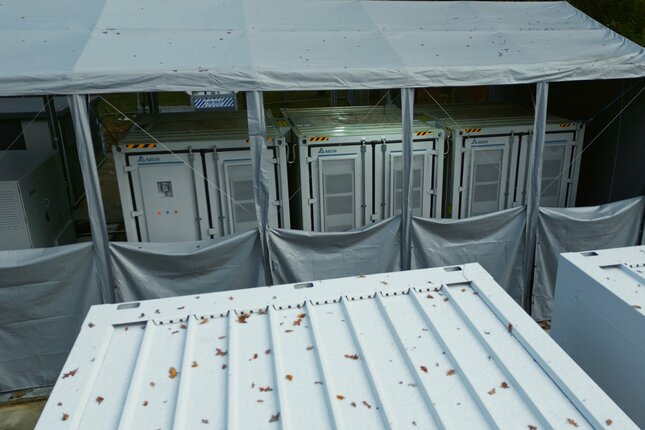Science, industry and government seek solution to grid congestion via large-scale living lab on ������ý campus
Commissioning of mega battery pack kicks off the development of a smart energy concept.

In the search for solutions to the current grid congestion problem, science, industry, and government are joining forces, killing two birds with one stone. With the OPZuid project GENIUS, ������ý wants to tackle grid congestion together with companies, municipalities, and the province and, at the same time, set up a sustainable testing ground for relevant future innovations. The starting signal is to commission a battery pack in the size of no less than a sea container for the storage of electrical energy on Monday, 18 November.

The GENIUS battery is essential to a smart control platform that aligns different industrial users, energy sources, and storage systems to prevent energy peaks. The lithium iron phosphate battery contains no cobalt or nickel and acts as energy storage and a control tool. It can coordinate and optimize complex data, allowing it to advise on and anticipate the energy needs of the more than forty faculty and business buildings on the ������ý campus, on which approximately fifteen thousand people depend daily. The energy hub is connected to the public energy grid, allowing energy to be fed back into the grid or shared with users in the local area.
Spreading the morning and evening rush hour
This battery pack balances the energy consumption better. Simply put, the congestion problem on the energy grid is solved by spreading the morning and evening rush hours. This offers room for further sustainability and expansion of the campus within the current contracted capacity. Think, for example, of heat pumps in combination with Heat and Cold Storage and the arrival of a new clean room.

The package easily pays for itself thanks to smart charging and discharging and peak shaving (energy storage when there is little demand and deployment during peak periods). For ������ý, it provides an estimated 20% extra space on its energy grid and capacity because less has to be purchased at unfavorable times (during 'rush hour'), which lowers the total costs.
This is also beneficial for the grid load in general because ������ý 'gets out of traffic jams' at such peak times. More gains can be made in (among other things) the areas of (minimal) CO2 emissions, balancing grid congestion at regional and national levels (������ý can consume more energy without increasing its connection, leaving capacity for the local area), energy security, peak reduction or the prevention of exceedances on the energy connection.
Blueprint for Dutch industry and grid operators
The system approach not only alleviates the energy needs of the (growing) ������ý campus and distributes them more efficiently but should also ultimately provide a blueprint for Dutch industry and grid operators to tackle grid congestion efficiently. Initially, for the approximately 3500 industrial estates in the Netherlands, mainly in the south of the Netherlands, where grid congestion is slowing down the energy transition and hindering economic growth. That blueprint could then be on the market in four years. This makes OPZuid GENIUS (Grid Efficiency Network Integration for Universal Sustainability) a strategic project with interest from society as a whole, in which open innovation predominates.
In fact, the project functions as a micro-society on campus, providing valuable knowledge about user behavior and how it is influenced and changed by insight into energy use patterns in the long term. This behavioral knowledge is crucial to developing strategies that drive effective behavioral change and promote energy efficiency.
Consortium around OPZuid GENIUS
������ý President of the Executive Board Robert-Jan Smits: "I am tremendously proud of this project because it brings together a lot of what we stand for as ������ý. With this we are working on sustainability, on solving the grid congestion that all of the entrepreneurial Netherlands is facing, and we are doing this - as a true 4th generation university - in collaboration with a wide range of partners in the region, focused on social impact.”
Mark Cox, Senior Program Manager Energy ������ý: "The GENIUS battery, in combination with intelligent software, can store energy when demand is low so that we can use it during peak times. Thanks to AI, other users, both on campus and in the local area, will not notice this. On the contrary, everyone can benefit from it. When the new Energy Act comes into effect next year, adjacent power grids can be connected. The cleverness of our system approach should then ensure that everyone is always supplied with energy without crossing borders."
Tom Selten, founder of Simpl.Energy: "With our software, we control the battery, charging stations, and solar panels so that ������ý always remains within the connection. In addition, we optimize the purchase of electricity, thereby minimizing energy costs. And as icing on the cake, with our platform, ������ý has one place where they can see whether all systems are working properly and how much is being earned and saved."
Daan Pelders, business developer Fudura: "At Fudura, we are proud to be able to participate in this innovative process. We are supplying one of the largest batteries in the Brainport area and integrating it into ������ý's private grid. We have been ������ý's partner in energy infrastructure and metering services for many years, and we are grateful for the trust we have received to carry out this project."
The consortium around OPZuid GENIUS consists of the following parties: ������ý department Real Estate, EIRES, EAISI, Fudura, RIFT, Simpl.Energy, Voltgoed, VBOptimum, ZEnMo, Cube Charging, Enerzien, Eindhoven Engine and Woonbedrijf. An active and connected support group includes the province and municipality, as well as the regional grid operator Enexis. This project was co-financed by the European Union through the award of an .
More on Sustainability


![[Translate to English:] Koen Kok in the Smart Grid Lab on the ������ý campus. Photo: Vincent van den Hoogen](https://assets.w3.tue.nl/w/fileadmin/_processed_/b/2/csm_TUe%20Koen%20Kok%20VvdH%200486_171dc2664d.jpg)
Latest news
![[Translate to English:] [Translate to English:]](https://assets.w3.tue.nl/w/fileadmin/_processed_/2/2/csm_Banner%20image%20Jaap%20van%20der%20Aar_4650434764.jpg)

